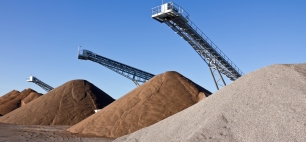Oeko-Institut designs a roadmap for a sustainable use of raw materials

Mehr Betonrecycling statt Kiesabbau ist notwendig
75 raw materials, 11 sustainability criteria, 4 areas of need and 2 scenarios – the transition to a sustainable use of raw materials makes a detailed analysis necessary. For a future raw materials policy that is sustainable, Oeko-Institut has defined material-specific targets and instruments for different groups of raw materials for the first time. In a second policy paper within the scope of the “Germany 2049: Transition to a sustainable use of raw materials” project, the team of researchers has determined – based on the example of neodymium and gravel – potentials for decreasing the environmental impacts of the four main use areas of housing, work, transport and information and communication technologies (ICT). The detailed comparison undertaken by the project team shows that for gravel – a bulk raw material in Germany – specific policy guidelines for reducing consumption and increasing the use of recycled building materials are essential. In the case of neodymium, which is expected to be increasingly used in the future for electric motors in, for example, electric cars, a certification of sustainably produced raw materials is necessary.
Gravel: longer lifetime of buildings and increased concrete recycling
The analysis of gravel as a raw material makes clear that the demand for this primary building material in Germany has to decrease significantly if a sustainable use of raw materials is to be achieved in future. Mining in gravel pits takes up a lot of space and destroys intact landscape and thus also animal and plant habitats. Therefore, the transition scenario assumes that the need for new buildings decreases due to a longer use of the existing building stock through forward-thinking renovation. In addition, it is assumed that more secondary materials (e.g. crushed concrete as a gravel substitute) are used in the construction of new buildings.
“We see high potentials for less primary gravel having to be mined in opencast mines in the future,” says Dr Matthias Buchert, leader of the “Germany 2049: The transition to sustainable raw materials management” project. “For this purpose, by 2049 the demand for raw materials for new buildings must be greatly reduced and more recycled concrete needs to be used. This is already technically possible but is seldom undertaken. The yearly demand for primary gravel can then be reduced by 23 million tonnes – which is approx. half of today’s demand and that of a business-as-usual scenario.”
To steer this transition, Oeko-Institut’s project team proposes the introduction of a tax for primary building materials. This should create incentives to conserve primary gravel reserves and to promote the use of recycled building materials.
The “Germany 2049: Transition to a sustainable use of raw materials” project
Since the summer of 2014, Oeko-Institut has been developing a comprehensive strategy for a transition to a sustainable use of raw materials within the scope of Oeko-Institut’s self-financed “Germany 2049” project. The mid-project results were presented and discussed in stakeholder workshops with participants from government, research, industry and NGOs. The results of these workshops were also incorporated in the two policy papers that have been published.
By the end of 2016, the project team will have defined targets for all groups of raw materials examined. Moreover, the team is also elaborating new and ambitious measures and instruments with which the targets for a transition to a sustainable use of raw materials in Germany can be achieved. These include, for instance, economic instruments, approaches for the certification of raw materials as well as demands for industrial sectors and companies to minimize risks to human rights and the environment in the value chain of their products. The final project results will be presented publicly for the first time at Oeko-Institut’s annual conference in Berlin on 1 December 2016.
Further information:
Presentations of stakeholder workshops on Oeko-Institut's project website (in German only)
More information on Oeko-Institut’s projects on resources and raw materials can be found on the Resource Fever website: www.ressourcenfieber.de.
Contact at Oeko-Institut:
Dr Matthias Buchert
Head of Resources & Transport Division
Oeko-Institut, Darmstadt office
Phone: +49 6151 8191-147
Email: m.buchert@oeko.de
Stefanie Degreif
Researcher in Resources & Transport Division
Oeko-Institut, Darmstadt office
Phone: +49 6151 8191-125
Email: s.degreif@oeko.de
Oeko-Institut is a leading independent European research and consultancy institute working for a sustainable future. Founded in 1977, the institute develops principles and strategies for ways in which the vision of sustainable development can be realised globally, nationally and locally. It has offices in three cities in Germany: Freiburg, Darmstadt and Berlin.
Follow Oeko-Institut on Twitter! twitter.com/oekoinstitut
eco@work – fit for the future!
Oeko-Institut’s e-paper. Subscribe at www.oeko.de/epaper_engl